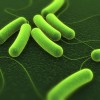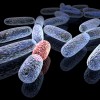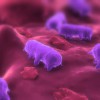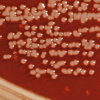 Escherichia coli is a bacterium found in the digestive system of healthy humans and animals and transmitted through fecal contamination. There are hundreds of known E. coli strains, with E. coli O157:H7 being the most recognized. This enterohemorrhagic E. coli (or EHEC) strain is responsible for an estimated 63,153 cases of infection and 20 deaths in the United States annually, and causes approximately $255 million in losses each year. E. coli are found everywhere in the environment but mostly occupy animal surfaces and digestive systems, making it important to thoroughly wash anything that comes into contact with these surfaces. This 5-page fact sheet was written by Keith R. Schneider, Renée Goodrich Schneider, Michael A. Hubbard, and Alexandra Chang, and published by the UF Department of Food Science and Human Nutrition, October 2013.
Escherichia coli is a bacterium found in the digestive system of healthy humans and animals and transmitted through fecal contamination. There are hundreds of known E. coli strains, with E. coli O157:H7 being the most recognized. This enterohemorrhagic E. coli (or EHEC) strain is responsible for an estimated 63,153 cases of infection and 20 deaths in the United States annually, and causes approximately $255 million in losses each year. E. coli are found everywhere in the environment but mostly occupy animal surfaces and digestive systems, making it important to thoroughly wash anything that comes into contact with these surfaces. This 5-page fact sheet was written by Keith R. Schneider, Renée Goodrich Schneider, Michael A. Hubbard, and Alexandra Chang, and published by the UF Department of Food Science and Human Nutrition, October 2013.
http://edis.ifas.ufl.edu/fs097
Tag: Keith R. Schneider
Preventing Foodborne Illness: E. coli “The Big Six”
 Escherichia coli is a bacterium usually found in the digestive system of healthy humans and animals and transmitted through fecal contamination. There are hundreds of known E. coli strains, with E. coli O157:H7 being the most widely recognized because of the severe illness it causes. In addition to E. coli O157:H7, the U.S. Food and Drug Administration has identified six serogroups (or “strains”), known as the “big six,” which includes E. coli O26, O45, O103, O111, O121, and O145. These are the most commonly seen types of E. coli found in food in the United States that are not O157:H7, and they cause approximately 37,000 cases per year in the United States. This 5-page fact sheet was written by Susanna Richardson, Renée Goodrich Schneider, and Keith R. Schneider, and published by the UF Department of Food Science and Human Nutrition, October 2013.
Escherichia coli is a bacterium usually found in the digestive system of healthy humans and animals and transmitted through fecal contamination. There are hundreds of known E. coli strains, with E. coli O157:H7 being the most widely recognized because of the severe illness it causes. In addition to E. coli O157:H7, the U.S. Food and Drug Administration has identified six serogroups (or “strains”), known as the “big six,” which includes E. coli O26, O45, O103, O111, O121, and O145. These are the most commonly seen types of E. coli found in food in the United States that are not O157:H7, and they cause approximately 37,000 cases per year in the United States. This 5-page fact sheet was written by Susanna Richardson, Renée Goodrich Schneider, and Keith R. Schneider, and published by the UF Department of Food Science and Human Nutrition, October 2013.
http://edis.ifas.ufl.edu/fs233
The Food Safety Modernization Act and the FDA Facility Registration Program
 The Food Safety Modernization Act that President Obama signed into law January 4, 2011 represents the most sweeping update to food safety regulation since the Federal Food, Drug, and Cosmetic Act of 1938. As part of FSMA, registration is required of facilities that manufacture, process, pack or hold food for human or animal consumption. This 3-page fact sheet was written by Susanna Richardson, Renée Goodrich Schneider, Mark A. Ritenour, Michelle D. Danyluk, and Keith R. Schneider, and published by the UF Department of Food Science and Human Nutrition, July 2013.
The Food Safety Modernization Act that President Obama signed into law January 4, 2011 represents the most sweeping update to food safety regulation since the Federal Food, Drug, and Cosmetic Act of 1938. As part of FSMA, registration is required of facilities that manufacture, process, pack or hold food for human or animal consumption. This 3-page fact sheet was written by Susanna Richardson, Renée Goodrich Schneider, Mark A. Ritenour, Michelle D. Danyluk, and Keith R. Schneider, and published by the UF Department of Food Science and Human Nutrition, July 2013.
http://edis.ifas.ufl.edu/fs231
La Seguridad en la Produccion de Alimentos en la Granja – Resumen de Buenas Practicas Agricolas (FSHN0601S/FS230)
 Las Buenas Prácticas Agrícolas (BPA) y Buenas Prácticas de Manejo (BPM) cubren los procedimientos generales que los productores, empacadores y procesadores de frutas y verduras frescas deben seguir para garantizar la seguridad de sus productos. Las BPA son usadas antes de la cosecha (es decir, en el campo), mientras que las BPM se utilizan luego de la cosecha, incluyendo el embalaje y envío. El objetivo de este panfleto es revisar los principios generalmente reconocidos como BPA en la producción de frutas y verduras frescas, sobre todo a nivel de fincas o granjas. Otros panfletos de la Extensián Cooperativa de la Florida sobre la Inocuidad de los Alimentos cubren los principios individuales en detalle, con énfasis especial en los cultivos y el manejo apropiado de los mismos en la Florida.
Las Buenas Prácticas Agrícolas (BPA) y Buenas Prácticas de Manejo (BPM) cubren los procedimientos generales que los productores, empacadores y procesadores de frutas y verduras frescas deben seguir para garantizar la seguridad de sus productos. Las BPA son usadas antes de la cosecha (es decir, en el campo), mientras que las BPM se utilizan luego de la cosecha, incluyendo el embalaje y envío. El objetivo de este panfleto es revisar los principios generalmente reconocidos como BPA en la producción de frutas y verduras frescas, sobre todo a nivel de fincas o granjas. Otros panfletos de la Extensián Cooperativa de la Florida sobre la Inocuidad de los Alimentos cubren los principios individuales en detalle, con énfasis especial en los cultivos y el manejo apropiado de los mismos en la Florida.
This 3-page fact sheet was written by Federico G. Caro, Renee Goodrich Schneider, Keith R. Schneider, y Douglas L. Archer, and published by the UF Department of Food Science and Human Nutrition, May 2013.
http://edis.ifas.ufl.edu/fs230
Preventing Foodborne Illness: Salmonellosis (FSHN0214/FS096)
 In 2007, there were over 1 million cases and some 400 deaths associated with Salmonella-contaminated food. In 2004, it was estimated that the total economic burden caused by Salmonella infection in the United States was $1.6–$5.3 billion. Food handlers, processors, and retailers can minimize the risk of salmonellosis by using good food handling practices. This 6-page fact sheet was written by Keith R. Schneider, Renée Goodrich Schneider, Michael A. Hubbard, and Susanna Richardson, and published by the UF Department of Food Science and Human Nutrition, March 2013.
In 2007, there were over 1 million cases and some 400 deaths associated with Salmonella-contaminated food. In 2004, it was estimated that the total economic burden caused by Salmonella infection in the United States was $1.6–$5.3 billion. Food handlers, processors, and retailers can minimize the risk of salmonellosis by using good food handling practices. This 6-page fact sheet was written by Keith R. Schneider, Renée Goodrich Schneider, Michael A. Hubbard, and Susanna Richardson, and published by the UF Department of Food Science and Human Nutrition, March 2013.
http://edis.ifas.ufl.edu/fs096
Preventing Foodborne Illness: Listeriosis (FSHN036/FS102)
 Listeriosis is one of several foodborne diseases that are often reported in the scientific and popular press. In the United States, it affects about 1,600 people every year, with about 270 of those cases resulting in death. It expresses itself in the affected person by means of septicemia, meningitis, and/or encephalitis. Pregnant women who have intrauterine or cervical infections caused by L. monocytogenes in their second or third trimesters may spontaneously abort the fetus or produce a stillbirth. Influenza-type symptoms, which may include continuous fever, usually precede the aforementioned disorders. This 4-page fact sheet was written by Keith R. Schneider, Renée Goodrich-Schneider, Michael A. Hubbard, and Susanna Richardson, and published by the UF Department of Food Science and Human Nutrition, March 2013.
Listeriosis is one of several foodborne diseases that are often reported in the scientific and popular press. In the United States, it affects about 1,600 people every year, with about 270 of those cases resulting in death. It expresses itself in the affected person by means of septicemia, meningitis, and/or encephalitis. Pregnant women who have intrauterine or cervical infections caused by L. monocytogenes in their second or third trimesters may spontaneously abort the fetus or produce a stillbirth. Influenza-type symptoms, which may include continuous fever, usually precede the aforementioned disorders. This 4-page fact sheet was written by Keith R. Schneider, Renée Goodrich-Schneider, Michael A. Hubbard, and Susanna Richardson, and published by the UF Department of Food Science and Human Nutrition, March 2013.
http://edis.ifas.ufl.edu/fs102
La Seguridad en la Produccion de Alimentos en la Granja: Buenas Practicas Agricolas y Buenas Practicas de Manejo series
 Las Buenas Prácticas Agrícolas (BPA) y las Buenas Prácticas de Manejo (BPM) abarcan los procedimientos generales que los productores, empacadores y procesadores de frutas y verduras frescas deben seguir para garantizar la seguridad de sus productos. Las BPA son usadas antes de la cosecha (es decir, en el campo), mientras que las BPM se utilizan luego de la cosecha, incluyendo el empaque y envío. Esta serie se centra en aspectos específicos del programa de BPA y cómo se relacionan con los cultivos y las prácticas de la Florida.
Las Buenas Prácticas Agrícolas (BPA) y las Buenas Prácticas de Manejo (BPM) abarcan los procedimientos generales que los productores, empacadores y procesadores de frutas y verduras frescas deben seguir para garantizar la seguridad de sus productos. Las BPA son usadas antes de la cosecha (es decir, en el campo), mientras que las BPM se utilizan luego de la cosecha, incluyendo el empaque y envío. Esta serie se centra en aspectos específicos del programa de BPA y cómo se relacionan con los cultivos y las prácticas de la Florida.
This series of fact sheets was written by Federico G. Caro, Alexandra Chang, Renée Goodrich-Schneider, y Keith R. Schneider, and published by the UF Department of Food Science and Human Nutrition, February 2013.
http://edis.ifas.ufl.edu/topic_series_spa_food_safety_on_the_farm
- Sanidad en las Instalaciones de Empaque (FSHN1205S/FS219)
http://edis.ifas.ufl.edu/fs219 - Salud e Higiene de los Trabajadores (FSHN1010S/FS220)
http://edis.ifas.ufl.edu/fs220 - Sanidad en el Campo (FSHN1012S/FS221)
http://edis.ifas.ufl.edu/fs221
Food Processing: The Meat We Eat (AN283)
 Meat processing technology is used to produce many of the foods we enjoy, such as hot dogs, hamburgers, and chicken nuggets. Recently, the media has focused on certain meat products, giving them names such as “pink slime” and “meat glue.” The names of these products might have many people wondering what we are eating and how the meat we eat is produced. Part of being a good consumer is learning about what you eat, from how the food is made to whether the food is safe. This publication discusses the facts about meat processing so you can make knowledgeable decisions about the meat you eat. This 5-page fact sheet was written by Erica L. Bub, Keith Schneider, Chad Carr, and Matt Hersom, and published by the UF Department of Animal Sciences, December 2012.
Meat processing technology is used to produce many of the foods we enjoy, such as hot dogs, hamburgers, and chicken nuggets. Recently, the media has focused on certain meat products, giving them names such as “pink slime” and “meat glue.” The names of these products might have many people wondering what we are eating and how the meat we eat is produced. Part of being a good consumer is learning about what you eat, from how the food is made to whether the food is safe. This publication discusses the facts about meat processing so you can make knowledgeable decisions about the meat you eat. This 5-page fact sheet was written by Erica L. Bub, Keith Schneider, Chad Carr, and Matt Hersom, and published by the UF Department of Animal Sciences, December 2012.
http://edis.ifas.ufl.edu/an283
Food Safety within the Household (FSHN12-10/FS195)
 Although food safety education is well established, people still become infected with foodborne illnesses by practicing unsafe behaviors in their kitchen. People who know the basics of home food safety may not always put theory into practice. Consumers must learn more about how food becomes unsafe to eat and modify their current beliefs and behaviors. This 5-page fact sheet was written by Lucianna Grasso, George L. Baker, Renée M. Goodrich-Schneider, and Keith R. Schneider, and published by the UF Department of Food Science and Human Nutrition, October 2012.
Although food safety education is well established, people still become infected with foodborne illnesses by practicing unsafe behaviors in their kitchen. People who know the basics of home food safety may not always put theory into practice. Consumers must learn more about how food becomes unsafe to eat and modify their current beliefs and behaviors. This 5-page fact sheet was written by Lucianna Grasso, George L. Baker, Renée M. Goodrich-Schneider, and Keith R. Schneider, and published by the UF Department of Food Science and Human Nutrition, October 2012.
http://edis.ifas.ufl.edu/fs195
Preventing Foodborne Illness: Yersiniosis (FSHN1209/FS193)
 Yersiniosis is an infectious disease caused by the consumption of food contaminated with the bacterium Yersinia. It is characterized by gastroenteritis, with diarrhea and/or vomiting, fever, abdominal pains, and skin rashes. Although outbreaks of yersiniosis are uncommon and sporadic in nature, foodborne outbreaks have been associated with consumption of contaminated food or water, and in places of high pork consumption. This 3-page fact sheet was written by Aswathy Sreedharan, Correy Jones, and Keith Schneider, and published by the UF Department of Food Science and Human Nutrition, June 2012. http://edis.ifas.ufl.edu/fs193
Yersiniosis is an infectious disease caused by the consumption of food contaminated with the bacterium Yersinia. It is characterized by gastroenteritis, with diarrhea and/or vomiting, fever, abdominal pains, and skin rashes. Although outbreaks of yersiniosis are uncommon and sporadic in nature, foodborne outbreaks have been associated with consumption of contaminated food or water, and in places of high pork consumption. This 3-page fact sheet was written by Aswathy Sreedharan, Correy Jones, and Keith Schneider, and published by the UF Department of Food Science and Human Nutrition, June 2012. http://edis.ifas.ufl.edu/fs193
Preventing Foodborne Illness: Shigellosis (FSHN0517/FS128)
 Shigellosis occurs when virulent Shigella organisms are consumed and invade the intestinal mucosa, resulting in tissue destruction. Most Shigella infections are spread by stools or soiled fingers of an infected person to the mouth of another person when basic hygiene and handwashing are not properly done. This 5-page fact sheet was written by Keith R. Schneider, Soohyoun Ahn, and Renée M. Goodrich-Schneider, and published by the UF Department of Food Science and Human Nutrition, July 2012.
Shigellosis occurs when virulent Shigella organisms are consumed and invade the intestinal mucosa, resulting in tissue destruction. Most Shigella infections are spread by stools or soiled fingers of an infected person to the mouth of another person when basic hygiene and handwashing are not properly done. This 5-page fact sheet was written by Keith R. Schneider, Soohyoun Ahn, and Renée M. Goodrich-Schneider, and published by the UF Department of Food Science and Human Nutrition, July 2012.
http://edis.ifas.ufl.edu/fs128
Preventing Foodborne Illness: Campylobacteriosis (FSHN032/FS098)
 Over 800,000 cases per year of diarrheal disease in the United States were linked to Campylobacter, being ranked No. 4 in the pathogens causing foodborne illnesses. Campylobacter is also responsible for 15% of foodborne illness-related hospitalizations, and 6% of foodborne illness-related deaths. This 5-page fact sheet was written by Soohyoun Ahn, Renée M. Goodrich-Schneider, and Keith R. Schneider, and published by the UF Department of Food Science and Human Nutrition, July 2012.
Over 800,000 cases per year of diarrheal disease in the United States were linked to Campylobacter, being ranked No. 4 in the pathogens causing foodborne illnesses. Campylobacter is also responsible for 15% of foodborne illness-related hospitalizations, and 6% of foodborne illness-related deaths. This 5-page fact sheet was written by Soohyoun Ahn, Renée M. Goodrich-Schneider, and Keith R. Schneider, and published by the UF Department of Food Science and Human Nutrition, July 2012.
http://edis.ifas.ufl.edu/fs098
Growth, Reduction, and Survival of Bacteria on Melon Types (FSHN1207/FS191)
 From 1990 to 2000, over 700 cases of foodborne illness were associated with outbreaks due to melon consumption in the U.S. and Canada. Even with efforts to educate industry and consumers of safe produce-handling practices, in the last decade there were still over 1,100 documented illnesses associated with melon consumption. This 45-page fact sheet highlights the research that has been done to provide insight on possible sanitation methods and their efficacy in decontaminating melon types of foodborne pathogens as well as natural microflora. Written by Thao P. Nguyen, Michelle D. Danyluk, and Keith R. Schneider, and published by the UF Department of Food Science and Human Nutrition, May 2012.
From 1990 to 2000, over 700 cases of foodborne illness were associated with outbreaks due to melon consumption in the U.S. and Canada. Even with efforts to educate industry and consumers of safe produce-handling practices, in the last decade there were still over 1,100 documented illnesses associated with melon consumption. This 45-page fact sheet highlights the research that has been done to provide insight on possible sanitation methods and their efficacy in decontaminating melon types of foodborne pathogens as well as natural microflora. Written by Thao P. Nguyen, Michelle D. Danyluk, and Keith R. Schneider, and published by the UF Department of Food Science and Human Nutrition, May 2012.
http://edis.ifas.ufl.edu/fs191
HACCP: An Overview (SHN0512/FS122)
 The acronym HACCP (pronounced /’hæ-sip/) stands for “Hazard Analysis Critical Control Point”. It is a food safety management system that is increasingly used in all aspects of the food industry. This 3-page fact sheet introduces the topic and summarizes the key components of a HACCP program. Written by R. Goodrich-Schneider, K. R. Schneider, M. D. Danyluk, and R. H. Schmidt, and published by the UF Department of Food Science and Human Nutrition, May 2012.
The acronym HACCP (pronounced /’hæ-sip/) stands for “Hazard Analysis Critical Control Point”. It is a food safety management system that is increasingly used in all aspects of the food industry. This 3-page fact sheet introduces the topic and summarizes the key components of a HACCP program. Written by R. Goodrich-Schneider, K. R. Schneider, M. D. Danyluk, and R. H. Schmidt, and published by the UF Department of Food Science and Human Nutrition, May 2012.
http://edis.ifas.ufl.edu/fs122
Outbreaks of Foodborne Diseases Associated with Tomatoes (FSHN1208/FS192)
 Concerned about the safety of fresh-market tomatoes? This 5-page fact sheet highlights tomato-related outbreaks in the United States and Europe and reviews the locations and venues of tomato preparations as well as the severity of outbreaks. Written by Angela M. Valadez, Keith R. Schneider, and Michelle D. Danyluk, and published by the UF Department of Food Science and Human Nutrition, May 2012.
Concerned about the safety of fresh-market tomatoes? This 5-page fact sheet highlights tomato-related outbreaks in the United States and Europe and reviews the locations and venues of tomato preparations as well as the severity of outbreaks. Written by Angela M. Valadez, Keith R. Schneider, and Michelle D. Danyluk, and published by the UF Department of Food Science and Human Nutrition, May 2012.
http://edis.ifas.ufl.edu/fs192
Growth, Reduction, and Survival of Bacteria on Tomatoes (FSHN1206/FS190)
 Tomato producers are committed to taking proactive steps to ensure and enhance the safety of their fresh-market tomatoes, but even with better food safety controls, the risk for outbreaks of illness associated with tomato consumption still exists. This 32-page fact sheet highlights current tomato safety related studies on the growth, reduction, and survival of bacteria on fresh-market tomatoes. The authors evaluated bacterial studies on natural antimicrobials and detergents, as well as food processing, cross-contamination, and shelf-life studies. Written by Angela M. Valadez, Keith R. Schneider, and Michelle D. Danyluk, and published by the UF Department of Food Science and Human Nutrition, May 2012.
Tomato producers are committed to taking proactive steps to ensure and enhance the safety of their fresh-market tomatoes, but even with better food safety controls, the risk for outbreaks of illness associated with tomato consumption still exists. This 32-page fact sheet highlights current tomato safety related studies on the growth, reduction, and survival of bacteria on fresh-market tomatoes. The authors evaluated bacterial studies on natural antimicrobials and detergents, as well as food processing, cross-contamination, and shelf-life studies. Written by Angela M. Valadez, Keith R. Schneider, and Michelle D. Danyluk, and published by the UF Department of Food Science and Human Nutrition, May 2012.
http://edis.ifas.ufl.edu/fs190
Food Safety on the Farm series
 These brief fact sheets are part of a collection that reviews the generally recognized principles of GAPs as they relate to produce, primarily at the farm level and with particular focus on fresh Florida crops and practices. Written by Keith R. Schneider, Renée M. Goodrich-Schneider, and Alexandra Chang, and published by the UF Department of Food Science and Human Nutrition, March 2012.
These brief fact sheets are part of a collection that reviews the generally recognized principles of GAPs as they relate to produce, primarily at the farm level and with particular focus on fresh Florida crops and practices. Written by Keith R. Schneider, Renée M. Goodrich-Schneider, and Alexandra Chang, and published by the UF Department of Food Science and Human Nutrition, March 2012.
- Worker Health and Hygiene (FSHN1010/FS158)
http://edis.ifas.ufl.edu/fs158 - Sanitary Facilities (FSHN1011/FS159)
http://edis.ifas.ufl.edu/fs159 - Field Sanitation (FSHN1012/FS160)
http://edis.ifas.ufl.edu/fs160 - Packing Facility Sanitation (FSHN1205/FS189)
http://edis.ifas.ufl.edu/fs189
European Food Safety Certification: The GlobalG.A.P® Standard and Its Accredited Certification Scheme (FSHN0801/FS145)
 Many European importers and retailers will only buy produce, meat, and grain-based products that come from GlobalG.A.P-certified farms. Despite its environmental origins, the main concern is food safety, followed by worker welfare, and then ecological matters. There are slightly different versions for fresh fruit and vegetables, meat products, flowers and ornamentals, and combinable crops (grains and pulses). There is also an Integrated Farm Assurance version for farms with several types of operations taking place at once. This 4-page fact sheet was written by Richard C. Yudin and Keith R. Schneider, and published by the UF Department of Food Science and Human Nutrition, February 2012.
Many European importers and retailers will only buy produce, meat, and grain-based products that come from GlobalG.A.P-certified farms. Despite its environmental origins, the main concern is food safety, followed by worker welfare, and then ecological matters. There are slightly different versions for fresh fruit and vegetables, meat products, flowers and ornamentals, and combinable crops (grains and pulses). There is also an Integrated Farm Assurance version for farms with several types of operations taking place at once. This 4-page fact sheet was written by Richard C. Yudin and Keith R. Schneider, and published by the UF Department of Food Science and Human Nutrition, February 2012.
http://edis.ifas.ufl.edu/fs145
Outbreaks of Foodborne Disease Associated with Fruit and Vegetable Juices, 1922 to 2010 (FSHN1204/FS188)
The FDA has recently mandated that all 100% fruit/vegetable juices sold wholesale be produced under a Hazard Analysis and Critical Control Point (HACCP) plan. As part of their HACCP plan, juice processors must identify and meet a target for reduction of the most resistant microorganism of public health significance that is likely to occur in the juice. This 7-page fact sheet aids juice processors in the identification of these “pertinent microorganisms,” and reviews the locations of juice preparations and severity of juice-associated outbreaks. Written by M. D. Danyluk, R. M. Goodrich-Schneider, K. R. Schneider, L. J. Harris, and R. W. Worobo, and published by the UF Department of Food Science and Human Nutrition, January 2012.
http://edis.ifas.ufl.edu/fs188
GAPs for the Florida Citrus Grower: Understanding the Principles of Good Agricultural Practices (FSHN1203/FS187)
 Growers are the first step in the farm-to-table food chain. Good Agricultural Practices (GAPs) refer to practices growers follow to prevent, minimize, or eliminate contamination and hazards to human health. Essential components of the GAPs process include careful planning, implementation, and documentation of required steps and procedures that together analyze and minimize risks imposed by biological, chemical, and physical hazards. The general guidelines presented in this document were developed by UF/IFAS for Florida citrus growers, in partnership with the citrus industry. This 8-page fact sheet was written by Michelle D. Danyluk, Renée M. Goodrich-Schneider, Keith R. Schneider, Mark A. Ritenour, and Timothy M. Spann, and published by the UF Department of Food Science and Human Nutrition, February 2012.
Growers are the first step in the farm-to-table food chain. Good Agricultural Practices (GAPs) refer to practices growers follow to prevent, minimize, or eliminate contamination and hazards to human health. Essential components of the GAPs process include careful planning, implementation, and documentation of required steps and procedures that together analyze and minimize risks imposed by biological, chemical, and physical hazards. The general guidelines presented in this document were developed by UF/IFAS for Florida citrus growers, in partnership with the citrus industry. This 8-page fact sheet was written by Michelle D. Danyluk, Renée M. Goodrich-Schneider, Keith R. Schneider, Mark A. Ritenour, and Timothy M. Spann, and published by the UF Department of Food Science and Human Nutrition, February 2012.
http://edis.ifas.ufl.edu/fs187